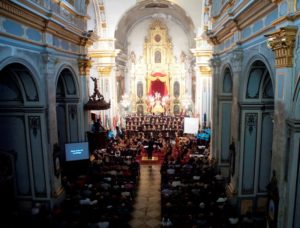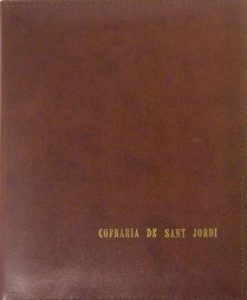José Luis Mansanet Ribes
If I had to summarize in the photographic boxes of a postcard my personal tourist impressions about Romania, I would place in a corner the immensity of the fir forests of the north of the country that can be calculated in days of bus travel. Somewhere else, Seghisoara and the fading of the legend of Dracula, invention of the English novel about the real existence in Transylvania of Prince Vlad el Dracul -the Devil-, born in that city, decapitator of heads of Turkish invaders, and Romanian national hero bothered by the myth of the vampire.
at another angle, the huge expanse of the capital Bucharest, which for a million and a half inhabitants occupies a surface area of about 50.000 hectares, something like 4 times the municipal term of Alcoy, In the fourth corner the Danube delta, fascinating place, where the river and the sediments of half Europe, that make you advance every year 40 meters in the sea, they make the flora and fauna weave a hymn to life that is savored by going through the intricate web of its innumerable channels. In the center of the postcard throughout Romania and its past, up to one of 4 mouth arms of the Danube in the sea, the oldest, his name is saint george.
for the traveler, in this case the alcoyano and of course the bañerense, tripping over st george, what is our pattern, produces first a feeling of flattery; there is something of ours, something that is familiar to us, something that other tourists do not have, what somehow places us above them, we tread on firmer ground.
And then it is obsessive to try to discover in each temple, in every corner, if Saint George is there, and of course it is!, not missing in any old church. For the group I was that man who is looking for Saint George, in a mixture of curiosity and affirmation of our being; and the obsession is contagious, to the extent that they help me, and between compassionate gestures and ironic looks they indicate to me: "see you, Sir, there is Saint George». And I have no choice but to tell you the history and legend of the Saint and why Saint George is our Patron.
In the city of Cluj-Napoca, in a park next to a 15th-century converted church, founded by Matías Corbino, stands a bronze equestrian statue of Saint George and the dragon, copy made for his hometown by the sculptor who made the statue of St. George found in Prague Castle. had to see it, I convinced the guide, that out of your way, pulled the group, grumbling about the lows, he got ready to contemplate the monument after a long walk through the streets of the city.
Of course, the emotion of the encounter with Saint George in other lands has a greater charm in a Bañerense than in an Alcoyano, because the iconography you see is that of the dragon, what is yours, and not the Matamoros, according to the special alcoyan invocation of its history generated in the mid-nineteenth century, where the spirituality of the Christian chivalric ideal of the fight against evil –the dragon- has become the real and plastic representation of what was the epic of the Reconquest, of which he was champion in Aragon, as Santiago was in Castile. But all that is another story.
North of the Moldova region, nucleus originating from present-day Romania, in Bukovina, during the time of Stephen the Great and successors, end of the fifteenth century and in the sixteenth century, emerges one of the most fabulous artistic treasures of Humanity, the group of monasteries of Voronet, Sucevita, Moldavita, Humov, Arbor, etc…, with his outdoor paintings, frescoes that fill all the exterior facades, and also the interior walls, following the byzantine trend, from the ceiling to the floor, in an orgy of colors and scenes, and in this case with predominance of a color as background: the blue in Voronet, the green tree, the yellowish in Suceavita.
The frescoes are a true "Illustrated Bible" with representations of the Last Judgment that occupy an entire façade, the Jeseo tree or genealogy of Jesus Christ, representation of the siege of Constantinople (the fight against the Turks was also an obsession of the Orthodox Christians).
Old Orthodox churches are generally small, and those of these medieval monasteries hardly have 30 oh 40 m. of long, for 6 oh 7 wide, all of them with the same frame structure, pronaos and naos where the altar is; with large eaves roofs, topped by one or two turrets. And the exterior walls were painted with the practical purpose of teaching the truths of faith to the peasant population with painting., generally illiterate, that did not fit inside. Let's not forget that there are no sculptures, because the Byzantines disapproved of them because of the iconoclastic question.
Among so many biblical scenes and saints, among so many thousands of paintings, the representation of Saint George could not be missing in such churches, which indeed appears in multiple forms: as a courtier of the emperor, or in the cortege of the military saints (Jorge, Demetrius, etc…) or in the legend of the dragon and the princess.
Saint George, what is the pattern of moldova, he is the titular saint of the church of Voronet, the most important of that artistic ensemble, that's why his effigy appears in the ship, in the iconostasis, on the altar, and that is why the votive scene –in front of the altar-, where the founder of the monastery is represented, Stephen the Great and his family, offering Jesus Christ the model of the temple, he does it through the intercession of Saint George, temple holder, who surrounds the King with his arms as a sign of protection. In a cool outside, next to the corner of the atrium, the legend of the dragon is represented.
in other churches, like the one in Arbore, on the western façade, the legend of Saint George is represented in great detail: his cavalcade, the reception that the emperor gives him, the banquet offered. In Moldovita, in the cool outside, appears with a dragon shooting flames from its mouth.
But perhaps where the life of the Saint is best represented is on the left side of the pronaos of the church of the Sucevita monastery., perhaps the Moldovan monument with the greatest profusion of images. There the life and martyrdom of the Saint, at least 10 panels throughout the entire pronaos with impressive realism. And of course it is in the iconostasis in a preferential place of the altar.
“però festa i fester” are not just any things, why continue. Admire the paintings in the churches of the Moldovan monasteries, exterior frescoes that are well preserved after five centuries, overwhelm the traveler, their grandeur falls on us before the impossibility of covering them. Saint George is profusely represented in all of them., his story, his legend… Finding it among thousands of paintings requires patience or that the guides indicate it to us, and time that the traveler lacks, always doomed to follow, to go ahead after the guide, It is a fight against the clock that is your worst enemy.
Despite the fleeting visions, one realizes the enormous importance that Saint George had in the Christian world of the Orthodox in the fourteenth to seventeenth centuries. And Romania is still today a testimony with its memories, of that devotion and admiration to the Holy Knight, prototype of the Christian chivalric ideal of those centuries.










